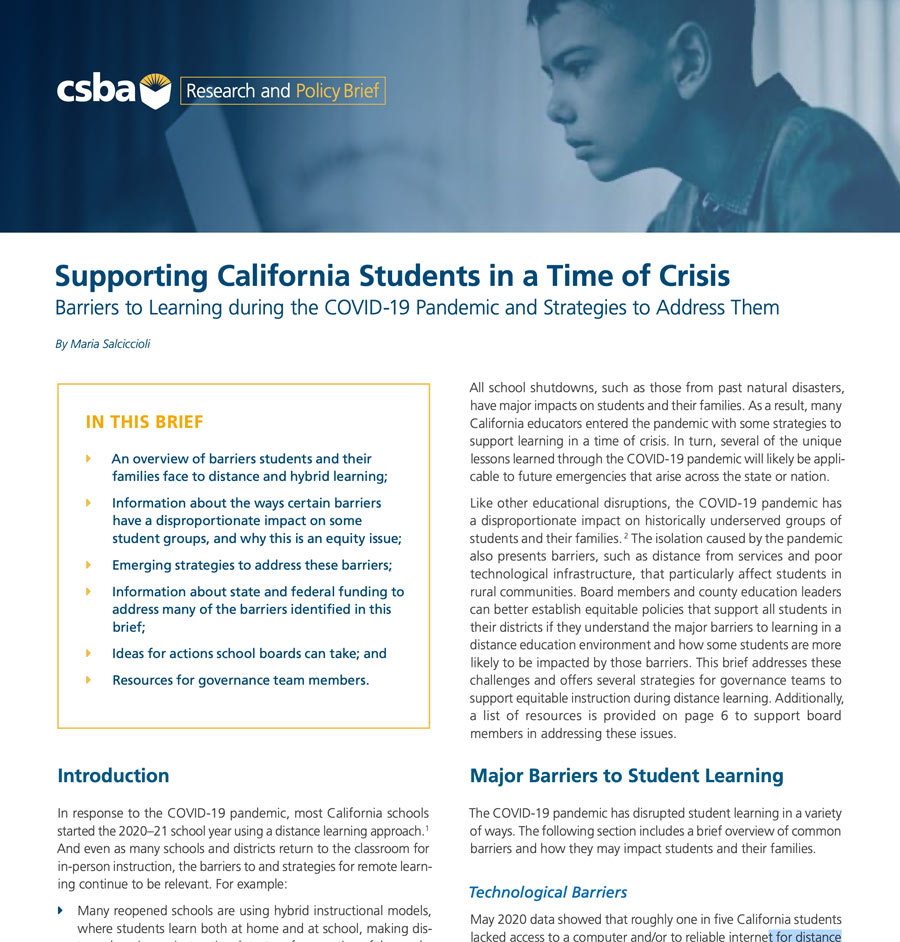“It is important to review all that we have learned over this past year of distance instruction,” said Mary Briggs, CSBA Director of Research and Policy. “While we don’t know what the future holds, some students have thrived with remote learning, but many have suffered. If we have another event that closes schools for a prolonged period, we must use the lessons learned from this pandemic to reduce barriers for students who struggled to learn online.”
Barriers to distance learning include a lack of a device or reliable internet connection; lack of communication or conflicting communication from teachers and administrators; and students’ home situations, which may include a lack of mental health support, siblings to care for and lack of space to do their schoolwork. While these barriers affect many students across the state, they have a disproportionate impact on underserved student groups that experience additional challenges, such as English learners, foster and homeless youth and students with disabilities.
The brief looks to real-world examples of how districts are overcoming these barriers to learning, including districts that have tackled technology challenges with external partnerships in which outside organizations are helping districts address access issues. Districts and county offices that created learning hubs, where they offer small groups of students in-person academic and social-emotional support. These hubs are especially important for underserved student groups, as mentioned above. To address communication difficulties, one rural district shared that district administrators communicated consistent learning expectations by sending streamlined, district-level information to all families. As a result, each school in the district was aligned, and families knew what to expect, even if their students attended different schools.
https://bit.ly/2Sn8mXk
“Understanding and Addressing Disruptions to Learning During the COVID-19 Pandemic”
https://bit.ly/2QRESRa
An influx of state and federal funds to local educational agencies must be used to safely open schools for in-person instruction and for student learning recovery and social-emotional well-being. “Understanding and Addressing Disruptions to Learning During the COVID-19 Pandemic” highlights a variety of strategies that LEAs can take to mitigate the negative impacts of learning disruptions.
It all begins with identifying student needs, which can be done without the use of summative assessments. In fact, formative assessments, “such as reviewing students’ oral or written work, or collecting ‘exit tickets’ (short end-of-lesson assessments) — can help educators identify students’ individual needs and personalize their instruction effectively,” according to brief author Maria Salciccioli, a senior research analyst at WestEd.
While remediation — where students are provided content from prior years — has been a common approach to catch students up on missed material, research shows that it can have unintended consequences of leaving students disengaged and further behind their peers. Acceleration is a more promising approach in which “teachers preview content for students; use new, grade-level content to teach prior-grade skills; and introduce relevant concepts from prior lessons to help prepare students to master upcoming standards.”
Other learning recovery strategies include providing targeted support in academic subjects vulnerable to learning loss like math through high-dosage tutoring; extending the school day and year, offering students more opportunities to engage with rich, meaningful academic content; professional development for teachers; and designated time for teacher collaboration and communication.
District and county board members can support learning recovery efforts by allocating resources for teacher professional learning and for supports for students likely to be significantly affected by pandemic-driven learning loss. Boards should use local student data to advocate for an equitable budget by emphasizing the disproportionate impact of learning loss on high-need students and underscoring the state’s requirement to target federal resources toward mitigating learning loss. Strategies for addressing learning loss, particularly for vulnerable student groups, must be addressed in the 2021–22 Local Control and Accountability Plan.
